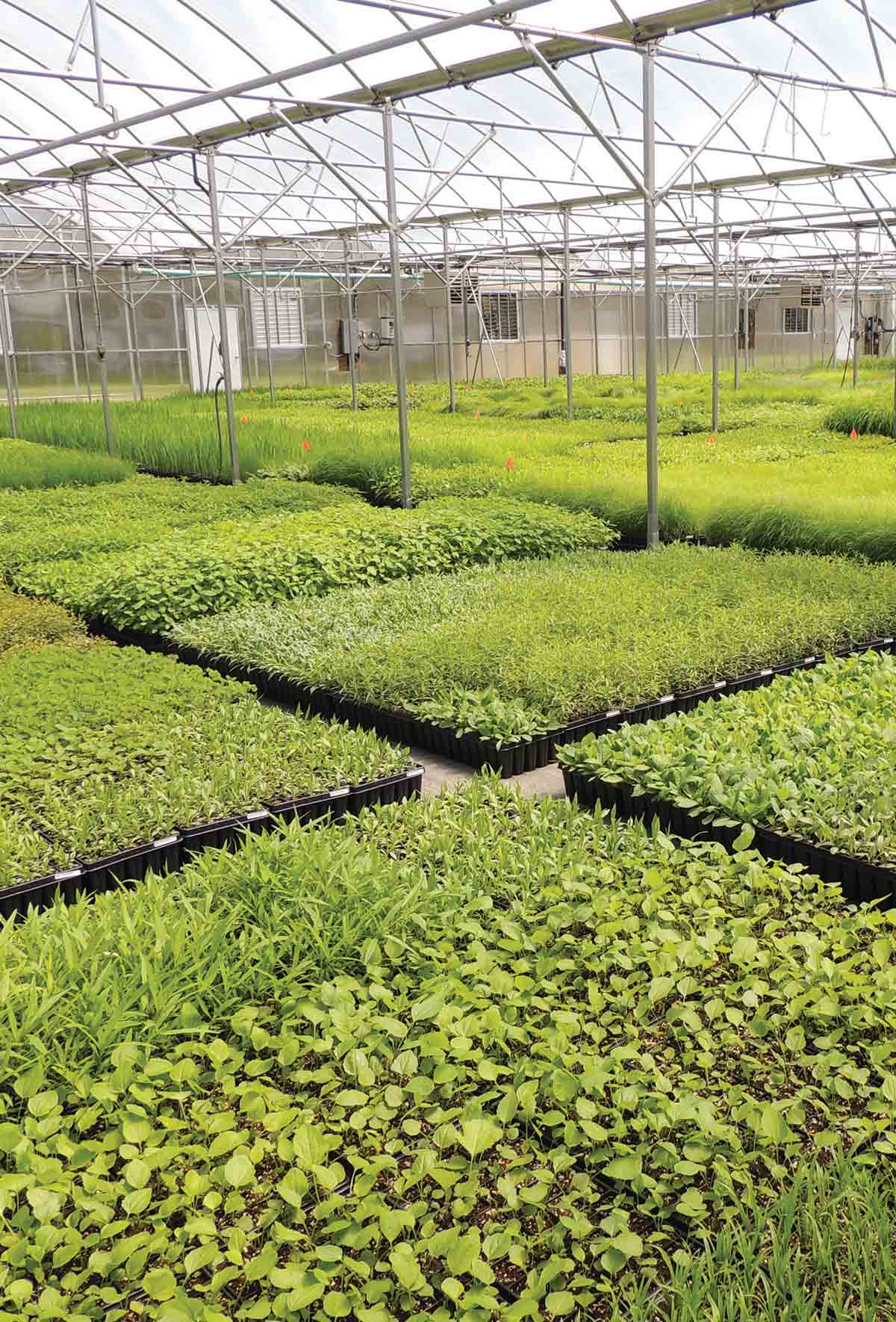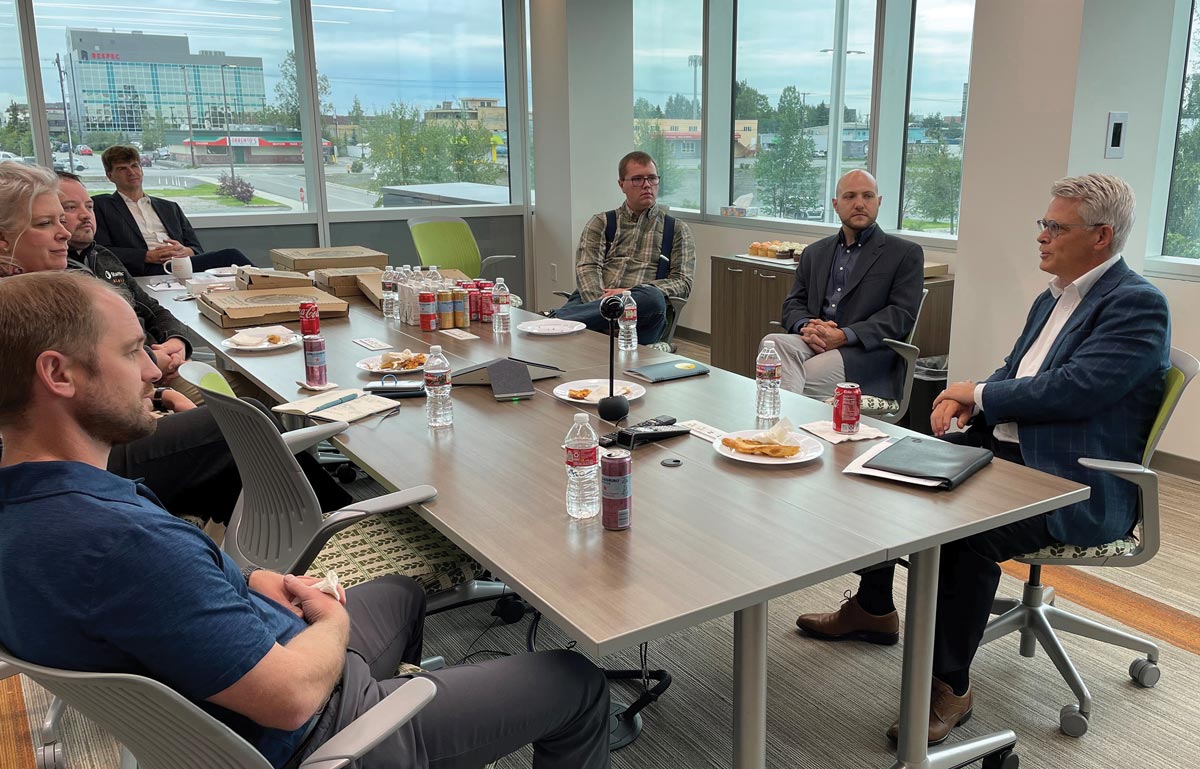
n mid-2022 Stantec President and CEO Gord Johnston visited Alaska to meet with clients, partners, and Alaska Stantec employees. He generously carved out time for an interview with Alaska Business Managing Editor Tasha Anderson, in which they talked about the company and Johnston’s role and vision for leading Stantec in continued growth.
Tasha Anderson: What’s a little bit of Stantec’s history, and how did the company come to Alaska?
Gord Johnston: The history of Stantec dates back to the mid-‘50s. We were started by a one-man show, his name was Don Stanley, from Edmonton [Alberta, Canada], which is where our head office is now… He came out of [Harvard University] with what they called at the time a doctorate in sanitation engineering and an offer to play professional hockey for the Boston Bruins. While professional hockey sounded interesting, he wanted to start an engineering company.
So he started Stanley Associates Engineering, although there were no associates [he laughs].
The western Canadian economy, particularly Alberta, is resource dependent, so Doc Stanley (as we called him) would build up to 200 people when times were good, and then he’d go down to 50, then he’d go up to a 1,000, and then he’d go down to a couple hundred. Over time he said, “I have to diversify from water and wastewater.”
They started doing buildings engineering and then oil and gas work, environmental work, architectural work, and so on. The company grew across Canada, and then in the early ‘90s we moved into the United States and acquired our first company in Phoenix, which was a land development company.
When we moved into the United States, we wanted to register the name Stanley Engineering, but there was one already. That’s where Stantec came from, [the combination of] “Stanley” and “technology,” because we do more than just engineering.
We acquired a company here [in Alaska] called USKH back in 2014, which is how we really got our presence here, and then when we acquired MWH [in 2015] they had offices here also…
And so we just kept going with that diversification strategy, geographically mostly. Our story is one of growth, really, and it’s growth both through acquisition and growth organically. We always say anybody can grow through acquisition, all you have to do is open your pocketbook, but growing organically is the real beauty…
[Even] through COVID our financial performance was record-breaking every year, and our backlog, which is how much work our clients have given to us that we haven’t executed yet, is at an all-time high. Our organic growth was, over last year, almost 10 percent, and our acquisition growth is strong as well: our earnings increased by 34 percent over last year. The company is operating extremely well.
Stantec

Stantec
Anderson: What are some of your more unique services?
Johnston: We just acquired a firm [in 2022] that does paleontological services, so hopefully we’ll call the next dinosaur they discover Stantecosaurus [he laughs]. But the reason we acquired that firm was because they’re based in California. PG&E [Pacific Gas and Electric Company] and other clients there, because of the wildfires that have been sparked by vegetation touching the power lines, want to bury some of the above-ground power lines. The first thing we need to do is archeological and paleontological services along the route…
We haven’t gotten into mine closure work here [in Alaska], not significantly, but in Australia we do mine closure work. In fact, a company that we just acquired there, called Cardno, was involved in helping create the specifications for mine closure in Australia and then secured the first major mine closure project there. And there’s billions and billions of dollars for mine closure that people forget about…
We do a little bit of construction work; we call it ecosystem restoration. For example, maybe an area’s been channelized: years ago everyone used to take a nice, naturalized stream, make it go straight, and pave it with concrete.
Anderson: Much better than nature intended it…
Johnston: Yeah, until you realize that it’s not [he laughs]. We go back in a lot of these areas and remove the concrete and re-naturalize the stream, do plantings. We actually have a native plant nursery in the Lower 48—it’s in the northeast—and we grow native plants and have a seed bank. When we do this type of work, we bring our plantings and native seeds from our greenhouse, and we also sell our seeds and our plantings to our competitors.
When we naturalize a stream, and then salmon come back and all these wonderful things, the client will get benefits from that, carbon sinks and so on, which they would sell. Sometimes we would buy them, because we’ve publicly stated our goal is to be carbon neutral by the end 2022, as a company.
Stantec

Stantec
Anderson: And is that on track?
Johnston: Yes. At the end of 2021, we were already carbon neutral in the UK, Europe, and I think Australia and New Zealand. And by the end of 2022 we were carbon neutral in all of our operations.
Anderson: What have you done to make that possible?
Johnston: A number of things. One is, of course, reducing our Scope 1 and 2 emissions. We’ve committed to a 47 percent reduction in Scope 1 and Scope 2 [emissions] from a 2019 baseline.
We’re also purchasing offsets. Some companies will purchase offsets just wherever they can get them, the cheapest place, but we purchase offsets in the country where we need the offset. For the UK, we’re purchasing offsets in the UK, and the same in Canada and the United States. They cost a little bit more, but we think they’re higher quality and they’re easier to certify, because this is an area that’s a bit of a wild west still.
Stantec

Stantec
Anderson: Clearly Stantec is environmentally minded, and some may think that sets the company at odds with some of the projects you design and the clients you work with. How do you approach balancing the need for development with protecting the environment?
Johnston: Our philosophy, 100 percent, is that development is necessary, and we just have to do all we can to minimize—you can never eliminate—but minimize the environmental impact of this development.
If you look at the work that we do in mining (in South America, Western Australia, Arizona, northern Canada, Alaska), we need these minerals if we’re going to continue to electrify, if we’re going to go to electric vehicles and things… We’ve got to strengthen the electrical grid because the grid’s not strong enough. If everyone needs to plug in their car, the grid can’t take it. [For the power project in southern California], moving the power lines underground, there is a huge need for copper for these things.
It’s the same mindset for the work we do with oil and gas companies. We’re involved, typically, on these projects from the beginning. We’ll help from the environmental perspective; how can we minimize the impact on plants and animals; we look at geotechnical, like the ground conditions; we’ll look at the slopes and the slope stability; we’ll look at minimizing creek crossings, or if one is necessary, where to do that. We’ll be there to work with environmental monitoring during construction. And then post construction, we’re involved with monitoring, as well: is there leak detection, is there slope stability issues.
So it’s my approach, but also that of our company, that there’s complete integration between the development and the environmental work required to support it.
We can’t stop development. Where I live, in Canada, it’s probably in the winter colder than it is here [in Anchorage] because you’ve got the buffering from the water. In Edmonton, where I grew up and where I live now, for weeks at a time -30°C temperatures are not uncommon, and some weeks are -40°C. And the only thing I need to know about minus forty is at minus forty Fahrenheit and Celsius are the same [he laughs].
It’s really cold. We need to burn fossil fuels in order to survive; there’s no alternative at -40°C, so we use natural gas for the most part in Edmonton, but other places in more rural areas would use propane, they’d use fuel oil, these sorts of things. So when staff approach me sometimes and say, “We have to get off fossil fuels,” I reply, “Okay, but that’s not something we can do in the short term.”
What we are going to continue to do is use our 4,500-person environmental group—20 percent of our company—to ensure that we minimize the environmental impact from all of this work. I’ve had people ask, “Will we, as Stantec, get out of oil and gas, or get out of our work in mining?” The answer is 100 percent no.
Left: Stantec provided the hydraulic design for the third set of locks for the Panama Canal.
Right: Johnston sits in front of the Kenaitze Indian Tribe’s new education center in Kenai—the Kahtnuht’ana Duhdeldiht Campus. Stantec’s Anchorage-based team led the design for the 67,000-square-foot facility, which opened in September 2022.
Stantec


Left: Stantec provided the hydraulic design for the third set of locks for the Panama Canal.
Right: Johnston sits in front of the Kenaitze Indian Tribe’s new education center in Kenai—the Kahtnuht’ana Duhdeldiht Campus. Stantec’s Anchorage-based team led the design for the 67,000-square-foot facility, which opened in September 2022.
Stantec
Anderson: So how often do your personal views align with Stantec’s, and have you had any tension in that space where your personal views are not exactly in line with the direction the company is going?
Johnston: No, and I think that’s one of the reasons why I was selected was that I have a pretty balanced approach. Stantec is not a political company. We fully believe in diversity and inclusion. We have 27,000 people now: we have people on any issue that will be way over here and we have people that will be way over here, and they both write me emails.
Our thought has been that we’re an engineering and architectural professional services company, and we don’t make statements on the latest Supreme Court decision or different things like that. We provide service to our clients, and that’s what we do.
Anderson: What’s a Stantec project that inspires you, on a personal level?
Johnston: We’ve done some massive projects and we’ve also done some very, very small projects. For example, we did the hydraulic design for the third set of locks for the Panama Canal, and we’ve been working on hydropower projects in Ethiopia…
We have 27,000 people around the world, and at any time we probably have between 30,000 and 40,000 projects that are open. Some of them are $500, some of them are $300 million. What I’m most proud of is that diversity.
We have a group right now that’s putting in water and sanitation for the first time for almost 1 million people in Egypt; we have people reducing water usage in the UK; we have people doing environmental work everywhere, from bat surveys to environmental work on PFAS [polyfluoroalkyl substances] chemicals. At Stantec, our purpose is, “We create communities and we design with community in mind,” so that’s what I love about us, or I’m most proud of, is the wide range of projects that we do that benefit our communities.![]()